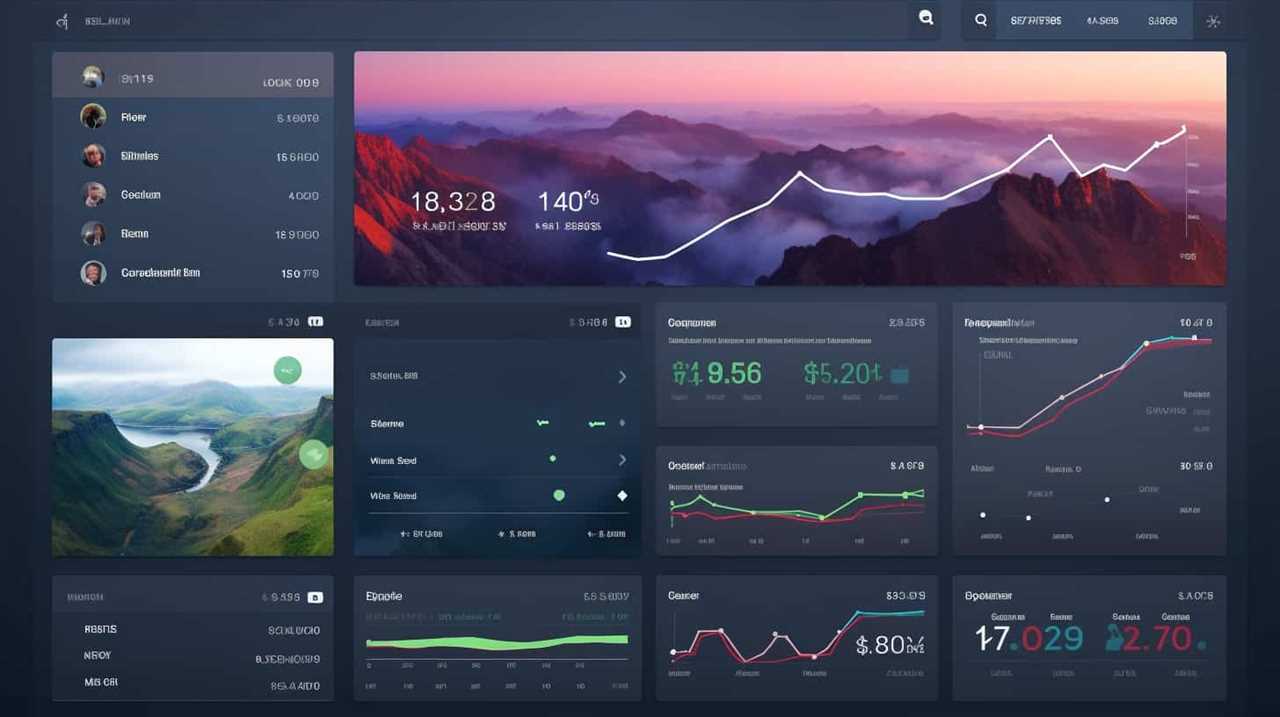We believe strongly in the power of personalized SEO strategies for custom tailoring and dressmaking companies. By utilizing our expertise, our goal is to link you with your perfect audience and boost your online presence.
By conducting thorough keyword research and creating high-quality content, we ensure that your website ranks higher on search engines and attracts the right customers.
We stay updated with the latest SEO trends and algorithms to maximize your success.
Let us guide you towards mastery in the world of tailored SEO.

Key Takeaways
- Tailored SEO is crucial for businesses in the fashion industry to attract potential customers and stay ahead of the competition.
- Understanding target audience preferences and search behavior helps optimize websites and create targeted content.
- Conducting keyword research helps optimize websites and rank higher in search engine results.
- Focusing on location-based keywords and creating location-specific landing pages enhances local search optimization.
The Importance of Tailored SEO
When it comes to custom tailoring and dressmaking services, the importance of tailored SEO can’t be overstated. In today’s digital age, having a strong online presence is crucial for any business to thrive. And for businesses in the fashion industry, such as custom tailoring and dressmaking services, optimizing their websites for search engines is essential to attract potential customers and stay ahead of the competition.
One key aspect of tailored SEO is the importance of on-page optimization. This involves optimizing the content, meta tags, headings, and URLs of a website to make it more search engine friendly. By strategically incorporating relevant keywords and providing valuable information to users, businesses can improve their rankings on search engine results pages (SERPs) and increase their organic visibility.
Another crucial element of tailored SEO is understanding the role of backlinks. Backlinks are links from other websites that point to your site. They act as votes of confidence and authority, signaling to search engines that your website is reputable and trustworthy. By actively building high-quality backlinks from authoritative fashion-related websites, custom tailoring and dressmaking services can boost their SEO rankings and increase their online visibility.
As we move forward in this discussion, it’s important to recognize that understanding your target audience is equally vital in tailoring your SEO strategies. By knowing who your potential customers are, their preferences, and their search behavior, you can further optimize your website and create targeted content that resonates with them.

Understanding Your Target Audience
Moving from the importance of tailored SEO, we now delve into understanding our target audience for custom tailoring and dressmaking services. Understanding target demographics is essential for creating engaging content that resonates with our audience and drives organic traffic to our website.
To gain a comprehensive understanding of our target audience, we need to analyze demographic data such as age, gender, location, and income level. By studying these factors, we can tailor our content and marketing strategies to meet their specific needs and preferences.
For instance, if our target audience consists mainly of young professionals in urban areas, we can create content that showcases trendy and fashionable designs suitable for their lifestyle. On the other hand, if our audience is predominantly older individuals living in suburban areas, we can focus on highlighting classic and timeless designs that cater to their taste.
Creating engaging content is crucial in capturing the attention of our target audience. We should focus on providing valuable information, such as style tips, fashion trends, and fabric choices, to establish ourselves as industry experts. Additionally, incorporating interactive elements like quizzes, polls, and tutorials can enhance user engagement and encourage them to stay on our website longer.

Conducting Keyword Research
When it comes to SEO, conducting keyword research is crucial for custom tailoring and dressmaking services. By identifying relevant keywords, we can optimize our website and content to rank higher in search engine results.
Additionally, targeting local search terms will help us reach our target audience and increase organic traffic to our website.
Relevant Keywords for SEO
First, we conduct keyword research to identify the most relevant keywords for optimizing SEO for our custom tailoring and dressmaking services. This step is crucial as it allows us to understand the search terms our potential customers are using and helps us tailor our content accordingly.
Here are three key points to consider when conducting keyword research:

- Long tail keywords for dressmaking: Long tail keywords are longer, more specific phrases that target a niche audience. For example, ‘bespoke wedding dress tailor’ or ‘custom-made suits for women.’ These keywords not only attract more qualified traffic but also have less competition, increasing our chances of ranking higher in search results.
- SEO strategies for custom tailoring businesses: It’s important to focus on local SEO strategies to target customers in specific locations. This includes optimizing our website for location-based keywords like ‘custom tailoring services in [city]’ and creating location-specific landing pages. Additionally, we can leverage customer reviews and testimonials to enhance our local SEO efforts.
- Keyword competition analysis: By analyzing the competition for specific keywords, we can identify areas of opportunity and refine our SEO strategy. We can use tools like Google Keyword Planner, SEMrush, or Moz to evaluate keyword difficulty, search volume, and competitor rankings. This analysis will help us prioritize the keywords with the highest potential for driving organic traffic to our website.
Targeting Local Search
To target local search effectively, we continue our keyword research by focusing on location-based keywords and creating location-specific landing pages. By incorporating local search optimization techniques, we can ensure that our custom tailoring and dressmaking services are easily discoverable by potential customers in our area. To begin, we need to identify the keywords that are most relevant to our local customers. This can be done by conducting keyword research using tools like Google Keyword Planner or SEMrush. Once we have a list of location-based keywords, we can create optimized landing pages that target specific areas or neighborhoods. This will help us attract local customers who are specifically looking for our services in their area. Now that we have identified the keywords and created the landing pages, it’s time to focus on creating high-quality content that will engage our local audience and drive conversions.
Keyword Research for Local Search Optimization
| Location | Tailoring Services | Dressmaking Services |
|---|---|---|
| New York | Tailoring in New York | Dressmaking in New York |
| Los Angeles | Tailoring in Los Angeles | Dressmaking in Los Angeles |
| London | Tailoring in London | Dressmaking in London |
By targeting these location-based keywords and creating location-specific landing pages, we can effectively optimize our website for local search and attract customers who are specifically looking for our services in their area.
Now, let’s move on to the next section about creating high-quality content.
Creating High-Quality Content
We believe that producing engaging and valuable content is key to optimizing SEO for custom tailoring and dressmaking services. By creating high-quality content, you can attract more visitors to your website and increase your chances of converting them into paying customers.

Here are three strategies to help you create content that will enhance your SEO efforts:
- Keyword Research: Conduct thorough keyword research to identify the terms and phrases your target audience is using to search for custom tailoring and dressmaking services. Incorporate these keywords naturally into your content to improve its visibility in search engine results.
- Educational Blog Posts: Share your expertise by creating informative and educational blog posts. Write about topics such as fabric types, garment care, and current fashion trends. This won’t only position you as an authority in your field but also attract potential customers who are looking for valuable information.
- Visual Content: Use high-quality images and videos to showcase your work and engage your audience. Visual content is highly shareable and can help improve your website’s visibility through social media platforms and image search results.
Optimizing Meta Tags and Descriptions
When it comes to optimizing our website for search engines, meta tags play a crucial role. These tags provide search engines with information about our web pages, helping them understand the content and context of our site.
Additionally, optimizing meta descriptions is essential as they provide a concise summary of our pages in search results, driving clicks and attracting potential customers.
Meta Tag Importance
Optimizing meta tags and descriptions plays a crucial role in enhancing the visibility and search engine ranking of our custom tailoring and dressmaking services. Meta tags are snippets of code that provide information about the content of a webpage to search engines. By optimizing these tags, we can improve our website’s performance in search engine results pages (SERPs).

Here are three strategies for optimizing meta tags for better search engine rankings:
- Using relevant keywords: Incorporating relevant keywords in meta tags helps search engines understand the content of our website and rank it accordingly.
- Writing compelling descriptions: Meta descriptions are brief summaries that appear in SERPs. Writing compelling and informative descriptions can entice users to click on our website.
- Keeping tags concise and unique: Search engines prefer concise and unique meta tags. By keeping our tags concise, we ensure that they accurately represent our content, while uniqueness helps differentiate our website from others.
Descriptions Drive Clicks
To drive clicks and improve search engine rankings, optimizing meta tags and descriptions is essential for our custom tailoring and dressmaking services. Writing compelling meta descriptions is crucial in enticing users to click on our website when they see it in search engine results. These descriptions should be concise, engaging, and provide a clear call to action. Additionally, incorporating visual content in our meta tags and descriptions can have a significant impact on driving clicks. People are naturally drawn to images, so including relevant and eye-catching visuals can make our listings stand out and increase click-through rates. By optimizing our meta tags and descriptions with compelling content and visually appealing elements, we can effectively attract more potential customers and improve our online visibility.
| Benefits of Optimizing Meta Tags and Descriptions | Impact of Visual Content | Example |
|---|---|---|
| Higher click-through rates | Attracts attention and increases engagement | Incorporating images of our custom-made dresses in meta descriptions |
| Improved search engine rankings | Enhances user experience and improves brand perception | Using infographics to showcase our tailoring process |
| Increased website traffic and conversions | Increases the likelihood of social sharing | Including a video of a dress fitting in our meta tags |
Table: The impact of optimizing meta tags and descriptions with visual content in driving clicks for our custom tailoring and dressmaking services.
Keywords and Relevancy
One key aspect of optimizing meta tags and descriptions for our custom tailoring and dressmaking services is ensuring the relevance of our keywords. By incorporating long tail keywords into our meta tags and descriptions, we can improve our SEO rankings and attract more targeted traffic to our website.

Long tail keywords are specific phrases that are more likely to be used by potential customers when searching for our services. Additionally, content marketing plays a crucial role in boosting keyword relevancy.
Implementing Local SEO Strategies
We have found that implementing effective local SEO strategies is crucial for maximizing the visibility and reach of custom tailoring and dressmaking services.
One key aspect of local SEO is optimizing local citations. Local citations are online mentions of your business name, address, and phone number (NAP) on other websites, directories, and platforms. By ensuring that your NAP information is consistent and accurate across all online platforms, you can improve your local search rankings.
Furthermore, managing your online reputation is essential for attracting and retaining customers. This involves monitoring and responding to online reviews, as well as actively seeking positive reviews from satisfied clients. Positive reviews not only boost your credibility and reputation but also serve as valuable social proof that can influence potential customers.

Additionally, optimizing your website for local keywords and geographic modifiers can help you target customers in specific locations. This includes incorporating relevant location-based keywords into your website content, meta tags, and headings.
Utilizing Social Media for SEO
Implementing effective local SEO strategies is crucial for maximizing the visibility and reach of custom tailoring and dressmaking services. Utilizing social media for SEO is another essential aspect of digital marketing. Social media engagement plays a significant role in driving organic traffic and improving search engine rankings.
Here are three ways to leverage social media for SEO:
- Creating high-quality content: Sharing valuable and relevant content on social media platforms increases brand visibility and encourages user engagement. By optimizing this content with relevant keywords and links, you can drive traffic to your website and improve its search ranking.
- Building a strong online presence: Active participation in social media platforms such as Facebook, Instagram, and Pinterest helps establish your brand as an authority in the field of custom tailoring and dressmaking. Engaging with your audience, responding to comments and messages, and sharing user-generated content can boost your social media presence and improve your SEO.
- Influencer collaborations: Partnering with influencers in the fashion and lifestyle industry can significantly enhance your brand visibility and reach. By collaborating with influencers who have a strong social media following, you can leverage their audience to promote your custom tailoring and dressmaking services. This not only increases brand awareness but also generates valuable backlinks, improving your website’s SEO performance.
Building High-Quality Backlinks
To boost our website’s SEO performance, we need to focus on acquiring high-quality backlinks. Building backlinks is crucial because search engines consider them as a vote of confidence for our website. However, it’s not just about the quantity of backlinks, but the quality that matters.

To achieve this, we can explore guest blogging opportunities and build relationships with industry influencers.
Guest blogging allows us to showcase our expertise and reach a wider audience. By writing valuable content for other relevant websites, we can include a link back to our own site. This not only drives referral traffic but also signals to search engines that our website is reputable and authoritative.
Another effective strategy is to build relationships with industry influencers. These influencers have a significant following and can provide us with valuable backlinks. By engaging with them through collaborations, interviews, or expert roundups, we can earn backlinks from their websites or social media platforms. This not only increases our website’s visibility but also enhances our credibility within the industry.
Optimizing Website Speed and Mobile Responsiveness
How can we ensure that our website provides a seamless user experience on both desktop and mobile devices? One crucial aspect is optimizing website speed and mobile responsiveness. Here are three key strategies to achieve this:

- Streamline website design: Simplify your website’s design by reducing unnecessary elements and using clean code. This will improve loading times and make it easier for mobile users to navigate.
- Optimize images: Large image files can slow down your website’s loading speed. Compress and resize images to reduce their file size without sacrificing quality. Additionally, consider using lazy loading techniques to only load images as they become visible on the user’s screen.
- Implement responsive design: Ensure that your website’s layout adapts seamlessly to different screen sizes. Responsive design allows users to have a consistent experience across devices, without having to zoom in or scroll excessively.
By focusing on website speed and mobile responsiveness, you can enhance user experience and keep visitors engaged.
In the next section, we’ll discuss how to further enhance user experience and navigation on your website.
Enhancing User Experience and Navigation
To enhance user experience and navigation on our website, we prioritize streamlining design and optimizing performance. By improving user engagement and reducing bounce rate, we aim to create a seamless and enjoyable browsing experience for our visitors.
One way we achieve this is through intuitive and user-friendly website design. We ensure that our menu and navigation elements are easily accessible and clearly labeled, allowing users to find the information they need quickly and effortlessly. Additionally, we utilize a responsive design approach to ensure our website is accessible and visually appealing across different devices and screen sizes.

Furthermore, we optimize the loading speed of our website to minimize any potential frustration for users. Studies have shown that a delay of just a few seconds can significantly impact bounce rates, so we prioritize efficient coding, image optimization, and caching techniques to ensure fast page load times.
In order to provide a visual representation of the strategies we implement to enhance user experience and navigation, we have created a table outlining some key elements:
| Key Elements | Description |
|---|---|
| Intuitive Navigation | Clear and easy-to-use menu and navigation structure |
| Responsive Design | Website adapts seamlessly to different devices and screen sizes |
| Fast Loading Speed | Optimized coding, image optimization, and caching techniques |
Implementing Schema Markup
When it comes to optimizing our custom tailoring and dressmaking services for search engines, implementing schema markup is a crucial step.
Schema markup is a type of structured data that helps search engines understand the content on our website more effectively.

Benefits of Schema Markup
Implementing schema markup provides numerous benefits for custom tailoring and dressmaking services. Here are three key advantages of using schema markup:
- Improved search engine visibility: Schema markup helps search engines understand the content on your website better. By providing structured data about your custom tailoring and dressmaking services, search engines can display more relevant information in search results, increasing your visibility and attracting more potential customers.
- Enhanced click-through rates: Schema markup allows you to display rich snippets in search results, such as star ratings, pricing information, and availability. These enticing snippets attract users’ attention and can significantly increase click-through rates to your website, driving more traffic and potential conversions.
- Better organic rankings: Schema markup provides search engines with additional context about your website’s content, making it easier for them to determine its relevance to users’ search queries. This can lead to improved organic rankings, helping your custom tailoring and dressmaking services appear higher in search results and attracting more targeted traffic.
Improving Search Visibility
We can enhance our search visibility by implementing schema markup for our custom tailoring and dressmaking services. Schema markup is a form of structured data that helps search engines understand the content on our website better.
By using schema markup, we can provide additional information about our services, such as the types of clothing we specialize in, the materials we use, and even customer reviews. This additional data makes it easier for search engines to index and display our website in relevant search results.
As a result, our website will have a higher chance of improving search rankings and attracting more organic traffic. Implementing schema markup is one of the most effective SEO strategies to increase our online visibility and reach our target audience.

Monitoring and Analyzing Website Performance
Monitoring and analyzing website performance is crucial for optimizing our custom tailoring and dressmaking services. By closely monitoring our website’s performance, we can identify areas of improvement and make data-driven decisions to enhance the user experience and increase conversions.
Here are three key aspects to consider when monitoring and analyzing website performance:
- Website Traffic: Tracking website traffic allows us to understand how many people are visiting our site, where they’re coming from, and which pages they’re visiting the most. By analyzing this data, we can identify the sources of our traffic and optimize our marketing strategies accordingly.
- Conversion Rate: Monitoring the conversion rate helps us determine how effective our website is in converting visitors into customers. By tracking the number of conversions and analyzing the factors that influence them, such as page layout, calls to action, and checkout process, we can make data-driven changes to improve our conversion rate.
- User Engagement: Examining user engagement metrics, such as bounce rate, time on site, and pages per session, provides valuable insights into how users are interacting with our website. By analyzing these metrics, we can identify areas where users may be experiencing difficulties or losing interest, and make necessary improvements to enhance user engagement.
By regularly monitoring and analyzing these key performance indicators, we can continuously optimize our website and provide an exceptional user experience.
In the next section, we’ll discuss the importance of staying updated with SEO trends and algorithms to further enhance our online presence and visibility.

Staying Updated With SEO Trends and Algorithms
To stay ahead in the ever-evolving world of SEO, it’s vital for us to stay updated with the latest trends and algorithms. Staying updated with search engine algorithms and adapting to changing SEO trends is crucial for the success of our tailored SEO strategies for custom tailoring and dressmaking services.
Search engine algorithms are constantly evolving to provide users with the most relevant and high-quality search results. As SEO professionals, we need to stay informed about these updates and adapt our strategies accordingly. By staying updated, we can ensure that our websites remain optimized and continue to rank well in search engine results.
Keeping track of the latest SEO trends is equally important. By understanding what users are searching for and how they engage with websites, we can tailor our content and optimize our websites to meet their needs. This includes staying updated with trends such as voice search, mobile optimization, and user experience.
Additionally, staying updated with SEO trends and algorithms allows us to stay ahead of our competition. By implementing the latest strategies and techniques, we can gain a competitive edge and attract more organic traffic to our websites.

Utilizing Online Directories and Review Sites
Utilizing online directories and review sites enhances our tailored SEO strategies for custom tailoring and dressmaking services. These platforms provide opportunities for us to showcase our expertise, build credibility, and attract potential customers. Here’s how we leverage online directories and review sites to optimize our SEO efforts:
- Managing online customer reviews:
We actively encourage our satisfied customers to leave reviews on popular review sites such as Yelp and Google My Business. Positive reviews not only boost our online reputation but also improve our search engine rankings. We promptly respond to both positive and negative reviews to show that we value customer feedback and are committed to providing exceptional service. - Local citation building:
We make sure our business information, such as name, address, and phone number, is consistent across all online directories. This helps search engines understand our location and improves our visibility in local search results. We also seek opportunities to get listed on niche directories related to fashion and tailoring, further enhancing our online presence. - Maximizing review site features:
We take advantage of additional features offered by review sites, such as adding photos of our work, responding to customer questions, and promoting special offers. These features not only engage potential customers but also contribute to our overall SEO strategy.
By effectively managing online customer reviews and leveraging local citation building, we enhance our tailored SEO strategies and increase our online visibility.
In the next section, we’ll discuss the importance of tracking and monitoring competitor SEO strategies to stay ahead in the industry.
Tracking and Monitoring Competitor SEO Strategies
When it comes to staying ahead in the competitive world of custom tailoring and dressmaking services, tracking and monitoring competitor SEO strategies is crucial.

By utilizing competitor analysis techniques, we can identify keyword opportunities that our competitors may be targeting and optimize our content accordingly.
This data-driven approach allows us to strategically position ourselves in the search engine rankings and attract a larger audience to our website.
Competitor Analysis Techniques
We actively track and monitor our competitors’ SEO strategies to stay ahead in the custom tailoring and dressmaking industry. Competitor analysis is a crucial aspect of our SEO strategy as it allows us to identify and understand what our competitors are doing to rank higher in search engine results.
Here are three key techniques we use for competitor analysis:

- Competitor keyword analysis: We analyze the keywords that our competitors are targeting in their SEO efforts. This helps us identify new keyword opportunities and refine our own keyword strategy.
- Backlink analysis: We closely examine the backlink profiles of our competitors to understand where their high-quality backlinks are coming from. This helps us identify potential link-building opportunities and improve our own backlink strategy.
- Content analysis: We analyze the content published by our competitors to understand the type of content that resonates with our target audience. This helps us create more engaging and relevant content that can attract more organic traffic.
Identifying Keyword Opportunities
Continuously tracking and monitoring our competitors’ SEO strategies enables us to uncover valuable keyword opportunities in the custom tailoring and dressmaking industry. By conducting competitive analysis, we can identify the keywords that our competitors are ranking for and leverage this information to optimize our own website.
To illustrate the importance of this process, let’s take a look at the following table showcasing the top long tail keywords used by our competitors:
| Competitor | Top Long Tail Keywords |
|---|---|
| Competitor A | custom wedding dress, bespoke tailoring, tailor near me, tailor-made suits |
| Competitor B | dress alterations, made-to-measure dresses, tailor services, custom clothing |
| Competitor C | dressmaker, tailor shop, alteration services, custom dress |
Analyzing our competitors’ keyword strategies helps us understand which terms are driving traffic and conversions. Armed with this knowledge, we can optimize our own website by targeting similar long tail keywords that are relevant to our business and have high search volume. By staying ahead of the competition and adapting our SEO strategies accordingly, we can increase our visibility and attract more potential customers.
Optimizing Content for SEO
To further optimize our website for SEO, we track and monitor our competitors’ strategies, specifically focusing on their SEO tactics. By analyzing their techniques, we can identify areas where we can improve our own content and stay ahead in the search rankings.

Here are three key aspects we consider when tracking and monitoring our competitors:
- Long tail keywords and their impact on SEO: We pay attention to the specific keywords our competitors are using in their content. This helps us identify popular long tail keywords that we may have missed and incorporate them into our own strategy.
- The role of user experience in SEO optimization: We analyze our competitors’ websites to see how they engage their users and provide a seamless browsing experience. By understanding what works well for them, we can enhance our own website’s user experience and improve our SEO rankings.
- Content quality and relevance: We evaluate the type of content our competitors are producing and how it aligns with their target audience. This allows us to identify content gaps and create high-quality, relevant content that will attract and engage our own audience.
Tracking and monitoring our competitors’ SEO strategies not only helps us stay informed about the latest trends and techniques but also provides valuable insights for improving our own SEO efforts.
Frequently Asked Questions
How Can I Track and Monitor Competitor SEO Strategies?
We track and monitor competitor SEO strategies through comprehensive competitor analysis. By analyzing their keywords, backlinks, and on-page optimization, we gain insights to improve our own SEO and stay ahead in the industry.
Are There Any Specific Online Directories and Review Sites That Are Best for Custom Tailoring and Dressmaking Services?
Yes, online reviews are crucial for custom tailoring and dressmaking services. They help build trust and attract local customers. We can effectively target them by optimizing our online presence, engaging with customers, and leveraging local directories and review sites.

What Are Some Ways to Enhance User Experience and Navigation on My Website?
Improving website loading speed and implementing responsive design are key to enhancing user experience and navigation. These strategies ensure a seamless browsing experience, keeping visitors engaged and increasing the likelihood of conversions.
How Can I Implement Schema Markup for My Custom Tailoring and Dressmaking Services?
To implement schema markup for our custom tailoring and dressmaking services, we focus on optimizing content by incorporating structured data. This enhances our website’s visibility, improves search engine rankings, and provides users with relevant and informative results.
Is It Important to Stay Updated With SEO Trends and Algorithms, and if So, How Can I Do That Effectively?
Staying updated with SEO trends and algorithms is crucial for effective digital marketing. To stay ahead, we analyze data, focus on keywords, and create engaging content. We also leverage the benefits of social media marketing for our custom tailoring and dressmaking services.
Conclusion
In conclusion, tailored SEO is like a well-fitted suit for your custom tailoring and dressmaking services. It helps you understand your target audience, create high-quality content, optimize meta tags and descriptions, and monitor website performance.

By staying updated with SEO trends and algorithms, utilizing online directories and review sites, and tracking competitor strategies, you can ensure your business stands out in the digital landscape.
Just like a perfectly tailored outfit, tailored SEO ensures your business looks its best and attracts the right audience.










